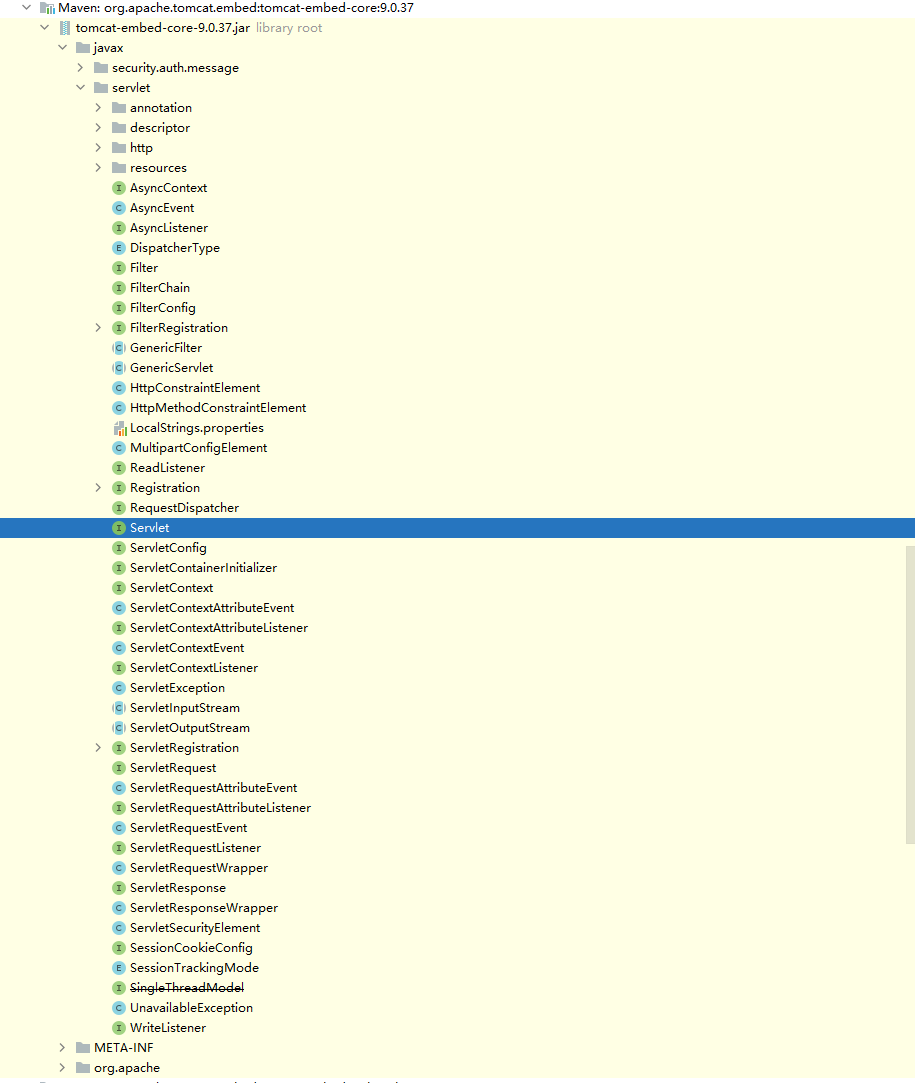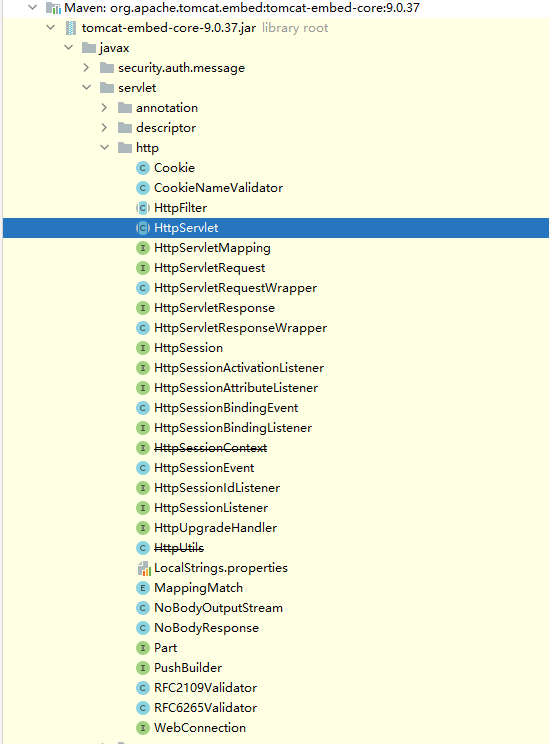Servlet源码阅读
通过全局搜索得到Servlet接口

这个包里包含Servlet涉及的全部内容。
使用版本:tomcat-embed-core-9.0.37
使用版本:tomcat-embed-core-9.0.37
使用版本:tomcat-embed-core-9.0.37
Servlet接口
作用:定义所有servlet必须实现的方法,该接口定义了初始化 servlet、服务请求以及从服务器中删除 servlet 的方法。
除了生命周期方法之外,该接口还提供了getServletConfig方法,servlet 可以使用该方法获取任何启动信息,以及getServletInfo方法,该方法允许 servlet 返回有关自身的基本信息,例如作者、版本和版权。
要实现此接口,您可以编写扩展javax.servlet.http.HttpServlet的通用 servlet 或扩展javax.servlet.GenericServlet的 HTTP servlet
生命周期方法按以下顺序调用:
- 构建 servlet,然后使用init()进行初始化。
- 处理来自客户端对service()的任何调用。
- servlet 停止服务,然后使用destroy()销毁,然后进行垃圾收集并完成。
public interface Servlet {
/**
* servlet 容器在实例化 servlet 后恰好调用一次init方法。init方法必须成功完成,servlet 才能接收任何请求。
*/
public void init(ServletConfig config) throws ServletException;
/**
* 返回一个ServletConfig对象,包含 servlet 的初始化和启动参数。
*/
public ServletConfig getServletConfig();
/**
* 由 servlet 容器调用以允许 servlet 响应请求。Servlet 通常在可以同时处理多个请求的多线程 Servlet 容器中运行。
*/
public void service(ServletRequest req, ServletResponse res)
throws ServletException, IOException;
/**
*返回有关 servlet 的信息,例如作者、版本和版权
*/
public String getServletInfo();
/**
* 由 servlet 容器调用以向 servlet 指示 servlet 正在停止服务。
*/
public void destroy();
}GenericServlet抽象类
作用:定义一个通用的、独立于协议的 servlet。提供一个Servlet模板,只要继承GenericServlet的Servlet实现,都会同时拥有Servlet和ServletConfig的API,并且GenericServlet已经对ServletConfig的API部分做了简单实现,在没有特殊要求的情况下,其无需重写,可直接使用。
要编写通用 servlet,您只需要重写抽象service方法
GenericServlet抽象类实现了Servlet, ServletConfig。这使得GenericServlet在具有Servlet API的同时,还新增了ServletConfig API。
package javax.servlet;
import java.io.IOException;
import java.util.Enumeration;
public abstract class GenericServlet implements Servlet, ServletConfig,
java.io.Serializable {
private static final long serialVersionUID = 1L;
private transient ServletConfig config;
/**
* 不做任何事情,所有 servlet 初始化都由init方法之一完成。
*/
public GenericServlet() {
// NOOP
}
/**
* 销毁方法
*/
public void destroy() {
// NOOP by default
}
/**
* 根据指定Key获取Servlet初始化参数.
*/
public String getInitParameter(String name) {
return getServletConfig().getInitParameter(name);
}
/**
* 获取Servlet初始化参数,结果在枚举中.
*/
public Enumeration<String> getInitParameterNames() {
return getServletConfig().getInitParameterNames();
}
/**
* 获取ServletConfig实例.
*/
public ServletConfig getServletConfig() {
return config;
}
/**
* 获取Servlet运行上线文对象ServletContent.
*/
public ServletContext getServletContext() {
return getServletConfig().getServletContext();
}
/**
* 返回有关 servlet 的信息,例如作者、版本和版权,重写此方法以使其返回有意义的值。
*/
public String getServletInfo() {
return "";
}
/**
* 给ServletConfig赋值,Servlet实例初始化
*/
public void init(ServletConfig config) throws ServletException {
this.config = config;
this.init();
}
/**
* 一种可以被覆盖的便捷方法,因此无需调用super.init(config)。重写即可
*/
public void init() throws ServletException {
// NOOP by default
}
/**
* 将指定的消息写入 servlet 日志文件,并以 servlet 的名称为前缀。
*/
public void log(String message) {
getServletContext().log(getServletName() + ": " + message);
}
/**
* 将给定Throwable异常的解释性消息和堆栈跟踪写入 servlet 日志文件,并以 servlet 的名称为前缀。
*/
public void log(String message, Throwable t) {
getServletContext().log(getServletName() + ": " + message, t);
}
/**
* 由 servlet 容器调用以允许 servlet 响应请求。
*/
public abstract void service(ServletRequest req, ServletResponse res)
throws ServletException, IOException;
/**
* 返回此 servlet 实例的名称。
*/
public String getServletName() {
return config.getServletName();
}
}HttpServlet抽象类
作用:提供一个抽象类,以创建适合网站的 HTTP servlet。要编写在 Web 上使用的 HTTP servlet,扩展javax.servlet.http.HttpServlet 。
HttpServlet的子类必须覆盖至少一种方法,doGet、doPost、doPut、doDelete、init和destroy、getServletInfo
几乎没有理由重写service方法。 service通过将标准 HTTP 请求分派给每个 HTTP 请求类型的处理程序方法(上面列出的do方法方法)来处理它们。同样,几乎没有理由重写doOptions和doTrace方法。
Servlet 通常在多线程服务器上运行,因此请注意 Servlet 必须处理并发请求并小心同步对共享资源的访问。
继承了GenericServlet抽象类

HttpServlet是专门为Web开发编写的Servlet模板类,在GenericServlet的基础上做了进一步的细分,就是我们常常看见的doXXX方法,
以及ServletRequest、ServletResponse到HttpServletRequest、HttpServletResponse的转换,整个类的设计更加符合基于HTTP的Web技术要求。
看下方法概览

package javax.servlet.http;
import java.io.IOException;
import java.io.OutputStreamWriter;
import java.io.PrintWriter;
import java.io.UnsupportedEncodingException;
import java.lang.reflect.InvocationTargetException;
import java.lang.reflect.Method;
import java.text.MessageFormat;
import java.util.Enumeration;
import java.util.ResourceBundle;
import javax.servlet.DispatcherType;
import javax.servlet.GenericServlet;
import javax.servlet.ServletException;
import javax.servlet.ServletOutputStream;
import javax.servlet.ServletRequest;
import javax.servlet.ServletResponse;
public abstract class HttpServlet extends GenericServlet {
private static final long serialVersionUID = 1L;
/** 一些字符串的声明, METHOD是method 哈哈熟悉了吧,方法的意思*/
private static final String METHOD_DELETE = "DELETE";
private static final String METHOD_HEAD = "HEAD";
private static final String METHOD_GET = "GET";
private static final String METHOD_OPTIONS = "OPTIONS";
private static final String METHOD_POST = "POST";
private static final String METHOD_PUT = "PUT";
private static final String METHOD_TRACE = "TRACE";
/** HEADER是Header*/
private static final String HEADER_IFMODSINCE = "If-Modified-Since";
private static final String HEADER_LASTMOD = "Last-Modified";
private static final String LSTRING_FILE =
"javax.servlet.http.LocalStrings";
private static final ResourceBundle lStrings =
ResourceBundle.getBundle(LSTRING_FILE);
/**
* 什么都不做,因为这是一个抽象类
*/
public HttpServlet() {
// NOOP
}
/**
* 允许 servlet 处理 GET 请求。GET 方法应该设计成是幂等的,可以安全地重复。
*/
protected void doGet(HttpServletRequest req, HttpServletResponse resp)
throws ServletException, IOException
{
String msg = lStrings.getString("http.method_get_not_supported");
sendMethodNotAllowed(req, resp, msg);
}
/**
* 返回上次修改HttpServletRequest对象的时间
*/
protected long getLastModified(HttpServletRequest req) {
return -1;
}
/**
* 从受保护的service方法接收 HTTP HEAD 请求并处理该请求。当客户端只想查看响应的标头(例如 Content-Type 或 Content-Length)时,它会发送 HEAD 请求。
*/
protected void doHead(HttpServletRequest req, HttpServletResponse resp)
throws ServletException, IOException {
if (DispatcherType.INCLUDE.equals(req.getDispatcherType())) {
doGet(req, resp);
} else {
NoBodyResponse response = new NoBodyResponse(resp);
doGet(req, response);
response.setContentLength();
}
}
/**
* 允许 servlet 处理 POST 请求。
*/
protected void doPost(HttpServletRequest req, HttpServletResponse resp)
throws ServletException, IOException {
String msg = lStrings.getString("http.method_post_not_supported");
sendMethodNotAllowed(req, resp, msg);
}
/**
* 由服务器调用(通过service方法)以允许 servlet 处理 PUT 请求。 PUT 操作允许客户端将文件放在服务器上,类似于通过 FTP 发送文件
*/
protected void doPut(HttpServletRequest req, HttpServletResponse resp)
throws ServletException, IOException {
String msg = lStrings.getString("http.method_put_not_supported");
sendMethodNotAllowed(req, resp, msg);
}
/**
* 由服务器调用(通过service方法)以允许 servlet 处理 DELETE 请求。 DELETE 操作允许客户端从服务器中删除文档或网页。
*/
protected void doDelete(HttpServletRequest req,
HttpServletResponse resp)
throws ServletException, IOException {
String msg = lStrings.getString("http.method_delete_not_supported");
sendMethodNotAllowed(req, resp, msg);
}
private void sendMethodNotAllowed(HttpServletRequest req, HttpServletResponse resp, String msg) throws IOException {
String protocol = req.getProtocol();
// Note: Tomcat reports "" for HTTP/0.9 although some implementations
// may report HTTP/0.9
if (protocol.length() == 0 || protocol.endsWith("0.9") || protocol.endsWith("1.0")) {
resp.sendError(HttpServletResponse.SC_BAD_REQUEST, msg);
} else {
resp.sendError(HttpServletResponse.SC_METHOD_NOT_ALLOWED, msg);
}
}
private static Method[] getAllDeclaredMethods(Class<?> c) {
if (c.equals(javax.servlet.http.HttpServlet.class)) {
return null;
}
Method[] parentMethods = getAllDeclaredMethods(c.getSuperclass());
Method[] thisMethods = c.getDeclaredMethods();
if ((parentMethods != null) && (parentMethods.length > 0)) {
Method[] allMethods =
new Method[parentMethods.length + thisMethods.length];
System.arraycopy(parentMethods, 0, allMethods, 0,
parentMethods.length);
System.arraycopy(thisMethods, 0, allMethods, parentMethods.length,
thisMethods.length);
thisMethods = allMethods;
}
return thisMethods;
}
/**
* OPTIONS:选项
* 由服务器调用(通过service方法)以允许 servlet 处理对应类型的请求。 OPTIONS 请求确定服务器支持哪些 HTTP 方法并返回适当的标头。
* 例如,如果 servlet 覆盖doGet ,则此方法返回以下标头:Allow: GET, HEAD, TRACE, OPTIONS
* 除非 servlet 实现了新的 HTTP 方法,而不是那些由 HTTP 1.1 实现的方法,否则没有必要重写此方法。
*/
protected void doOptions(HttpServletRequest req,
HttpServletResponse resp)
throws ServletException, IOException {
Method[] methods = getAllDeclaredMethods(this.getClass());
boolean ALLOW_GET = false;
boolean ALLOW_HEAD = false;
boolean ALLOW_POST = false;
boolean ALLOW_PUT = false;
boolean ALLOW_DELETE = false;
boolean ALLOW_TRACE = true;
boolean ALLOW_OPTIONS = true;
// Tomcat specific hack to see if TRACE is allowed
Class<?> clazz = null;
try {
clazz = Class.forName("org.apache.catalina.connector.RequestFacade");
Method getAllowTrace = clazz.getMethod("getAllowTrace", (Class<?>[]) null);
ALLOW_TRACE = ((Boolean) getAllowTrace.invoke(req, (Object[]) null)).booleanValue();
} catch (ClassNotFoundException | NoSuchMethodException | SecurityException |
IllegalAccessException | IllegalArgumentException | InvocationTargetException e) {
// Ignore. Not running on Tomcat. TRACE is always allowed.
}
// End of Tomcat specific hack
for (int i=0; i<methods.length; i++) {
Method m = methods[i];
if (m.getName().equals("doGet")) {
ALLOW_GET = true;
ALLOW_HEAD = true;
}
if (m.getName().equals("doPost"))
ALLOW_POST = true;
if (m.getName().equals("doPut"))
ALLOW_PUT = true;
if (m.getName().equals("doDelete"))
ALLOW_DELETE = true;
}
String allow = null;
if (ALLOW_GET)
allow=METHOD_GET;
if (ALLOW_HEAD)
if (allow==null) allow=METHOD_HEAD;
else allow += ", " + METHOD_HEAD;
if (ALLOW_POST)
if (allow==null) allow=METHOD_POST;
else allow += ", " + METHOD_POST;
if (ALLOW_PUT)
if (allow==null) allow=METHOD_PUT;
else allow += ", " + METHOD_PUT;
if (ALLOW_DELETE)
if (allow==null) allow=METHOD_DELETE;
else allow += ", " + METHOD_DELETE;
if (ALLOW_TRACE)
if (allow==null) allow=METHOD_TRACE;
else allow += ", " + METHOD_TRACE;
if (ALLOW_OPTIONS)
if (allow==null) allow=METHOD_OPTIONS;
else allow += ", " + METHOD_OPTIONS;
resp.setHeader("Allow", allow);
}
/**
* TRACE 将随 TRACE 请求一起发送的标头返回给客户端,以便在调试中使用它们。无需重写此方法
*/
protected void doTrace(HttpServletRequest req, HttpServletResponse resp)
throws ServletException, IOException
{
int responseLength;
String CRLF = "\r\n";
StringBuilder buffer = new StringBuilder("TRACE ").append(req.getRequestURI())
.append(" ").append(req.getProtocol());
Enumeration<String> reqHeaderEnum = req.getHeaderNames();
while( reqHeaderEnum.hasMoreElements() ) {
String headerName = reqHeaderEnum.nextElement();
buffer.append(CRLF).append(headerName).append(": ")
.append(req.getHeader(headerName));
}
buffer.append(CRLF);
responseLength = buffer.length();
resp.setContentType("message/http");
resp.setContentLength(responseLength);
ServletOutputStream out = resp.getOutputStream();
out.print(buffer.toString());
out.close();
}
/**
* 从公共service方法接收标准 HTTP 请求,并将它们分派到此类中定义的do Method方法。
*/
protected void service(HttpServletRequest req, HttpServletResponse resp)
throws ServletException, IOException {
String method = req.getMethod();
if (method.equals(METHOD_GET)) {
// Get类型调用
long lastModified = getLastModified(req);
if (lastModified == -1) {
// servlet 不支持 if-modified-since,不用处理复杂的逻辑
doGet(req, resp);
} else {
long ifModifiedSince;
try {
ifModifiedSince = req.getDateHeader(HEADER_IFMODSINCE);
} catch (IllegalArgumentException iae) {
// 如果是无效的DateHeader依然像没有设置一样继续
ifModifiedSince = -1;
}
if (ifModifiedSince < (lastModified / 1000 * 1000)) {
// If the servlet mod time is later, call doGet()
// Round down to the nearest second for a proper compare
// A ifModifiedSince of -1 will always be less
maybeSetLastModified(resp, lastModified);
doGet(req, resp);
} else {
resp.setStatus(HttpServletResponse.SC_NOT_MODIFIED);
}
}
} else if (method.equals(METHOD_HEAD)) {
// Head类型调用
long lastModified = getLastModified(req);
maybeSetLastModified(resp, lastModified);
doHead(req, resp);
} else if (method.equals(METHOD_POST)) {
// Post类型调用
doPost(req, resp);
} else if (method.equals(METHOD_PUT)) {
// Put类型调用
doPut(req, resp);
} else if (method.equals(METHOD_DELETE)) {
// Delete类型调用
doDelete(req, resp);
} else if (method.equals(METHOD_OPTIONS)) {
// Options类型调用
doOptions(req,resp);
} else if (method.equals(METHOD_TRACE)) {
// Trace类型调用
doTrace(req,resp);
} else {
// 没有 servlet 支持在此服务器上的任何位置请求的任何方法
String errMsg = lStrings.getString("http.method_not_implemented");
Object[] errArgs = new Object[1];
errArgs[0] = method;
errMsg = MessageFormat.format(errMsg, errArgs);
resp.sendError(HttpServletResponse.SC_NOT_IMPLEMENTED, errMsg);
}
}
/*
* 如果尚未设置且值有意义,则设置 Last-Modified 实体标头字段。在 doGet 之前调用,以确保在写入响应数据之前设置标头。一个子类可能已经设置了这个头,所以我们检查一下。
*/
private void maybeSetLastModified(HttpServletResponse resp,
long lastModified) {
if (resp.containsHeader(HEADER_LASTMOD))
return;
if (lastModified >= 0)
resp.setDateHeader(HEADER_LASTMOD, lastModified);
}
/**
* 将客户端请求分派到受保护的service方法。无需重写此方法。
*/
@Override
public void service(ServletRequest req, ServletResponse res)
throws ServletException, IOException {
HttpServletRequest request;
HttpServletResponse response;
try {
request = (HttpServletRequest) req;
response = (HttpServletResponse) res;
} catch (ClassCastException e) {
throw new ServletException(lStrings.getString("http.non_http"));
}
service(request, response);
}
}
/*
* 无主体Response实现.
*/
class NoBodyResponse extends HttpServletResponseWrapper {
private final NoBodyOutputStream noBody;
private PrintWriter writer;
private boolean didSetContentLength;
// file private
NoBodyResponse(HttpServletResponse r) {
super(r);
noBody = new NoBodyOutputStream(this);
}
// file private
void setContentLength() {
if (!didSetContentLength) {
if (writer != null) {
writer.flush();
}
super.setContentLength(noBody.getContentLength());
}
}
// SERVLET RESPONSE interface methods
@Override
public void setContentLength(int len) {
super.setContentLength(len);
didSetContentLength = true;
}
@Override
public void setContentLengthLong(long len) {
super.setContentLengthLong(len);
didSetContentLength = true;
}
@Override
public void setHeader(String name, String value) {
super.setHeader(name, value);
checkHeader(name);
}
@Override
public void addHeader(String name, String value) {
super.addHeader(name, value);
checkHeader(name);
}
@Override
public void setIntHeader(String name, int value) {
super.setIntHeader(name, value);
checkHeader(name);
}
@Override
public void addIntHeader(String name, int value) {
super.addIntHeader(name, value);
checkHeader(name);
}
private void checkHeader(String name) {
if ("content-length".equalsIgnoreCase(name)) {
didSetContentLength = true;
}
}
@Override
public ServletOutputStream getOutputStream() throws IOException {
return noBody;
}
@Override
public PrintWriter getWriter() throws UnsupportedEncodingException {
if (writer == null) {
OutputStreamWriter w;
w = new OutputStreamWriter(noBody, getCharacterEncoding());
writer = new PrintWriter(w);
}
return writer;
}
}
/*
* 与NoBodyResponse对应的输出流.
*/
class NoBodyOutputStream extends ServletOutputStream {
private static final String LSTRING_FILE =
"javax.servlet.http.LocalStrings";
private static final ResourceBundle lStrings =
ResourceBundle.getBundle(LSTRING_FILE);
private final HttpServletResponse response;
private boolean flushed = false;
private int contentLength = 0;
// file private
NoBodyOutputStream(HttpServletResponse response) {
this.response = response;
}
// file private
int getContentLength() {
return contentLength;
}
@Override
public void write(int b) throws IOException {
contentLength++;
checkCommit();
}
@Override
public void write(byte buf[], int offset, int len) throws IOException {
if (buf == null) {
throw new NullPointerException(
lStrings.getString("err.io.nullArray"));
}
if (offset < 0 || len < 0 || offset+len > buf.length) {
String msg = lStrings.getString("err.io.indexOutOfBounds");
Object[] msgArgs = new Object[3];
msgArgs[0] = Integer.valueOf(offset);
msgArgs[1] = Integer.valueOf(len);
msgArgs[2] = Integer.valueOf(buf.length);
msg = MessageFormat.format(msg, msgArgs);
throw new IndexOutOfBoundsException(msg);
}
contentLength += len;
checkCommit();
}
@Override
public boolean isReady() {
// TODO SERVLET 3.1
return false;
}
@Override
public void setWriteListener(javax.servlet.WriteListener listener) {
// TODO SERVLET 3.1
}
private void checkCommit() throws IOException {
if (!flushed && contentLength > response.getBufferSize()) {
response.flushBuffer();
flushed = true;
}
}
}